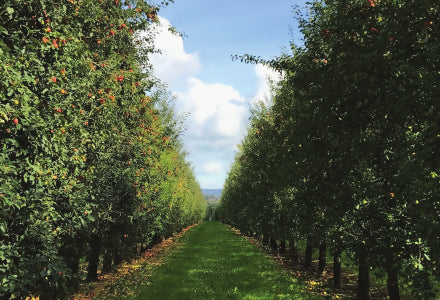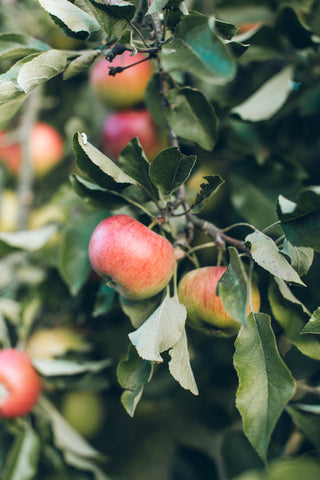Rarity Club: Coquerel Calvados Single Cask 24 Ans
Calvados, like Cognac, is almost always a blend of many separately aged eaux-de-vie, so to find a single cask expression, let alone one that's been aged this long, is rare indeed. And because it comes from a single cask and not a blend, it can never be repeated. The 270 bottles produced are all that will ever exist.
A Single Cask, A Singular Calvados
If you’re not familiar with calvados, get ready to make the acquaintance of one of the world’s most beautiful distilled spirits. And if you think you know your calvados, think again, for this bottle of Coquerel calvados that’s made its way to you across an ocean and nearly a quarter century is an outlier, a... well, we don’t want to trot out the “unicorn” cliché, but it’s distinctive and quite different from almost any calvados you’ll encounter.

A Historic Battle Introduces Calvados To America
Calvados is, technically speaking at least, apple brandy. But calvados is to apple brandy as cognac is to grape brandy, or champagne is to sparkling wine. It’s been made in Normandy for centuries — the earliest known reference to “eau de vie de Sydre” goes back to 1553 — but its production and geographical boundaries have only been legally codified since 1942, when the Calvados name was given an Appellation d’Origine Controlée (AOC) by the French government.
France was occupied by the Nazis at the time, and “any product which was not an AOC could be taken in its entirety to use for the army,” says Jean-Francois Bonneté, co-founder and president/CEO of Bonneté Inc., which imports Coquerel and many other spirits into the U.S. “So Calvados got an AOC to protect their product.” Calvados became known in America thanks to the soldiers who landed in Normandy in 1944 for one of World War II’s most legendary battles. “When the GI’s first arrived in Normandy,” says Bonneté, “on the beach at D-Day, they needed a little shot of something — because God knows they needed it. And it was a shot of calvados. When they came back to the U.S., [they] came back with a bottle of calvados.”

This photo depicts how the soldier wrapped the end of the line around his middle and served as a “human anchor” in the midst of enemy fire. Of the 36 invaders who attempted to follow the line ashore, only six made it.

American Army and Navy chiefs pay their first visit to French soil to witness the progress of battle on the beachheads to France. June 12, 1944
Getting to Know Calvados and Coquerel
At the time, the house of Coquerel was in its infancy, having been founded in 1937 by Rene Gilbert. Today, it’s run by the third generation of the family, Pierre Martin Neuhaus, While it’s the largest independent family-owned calvados distillery to export its product, it’s still small by the standards of other spirits. Bonneté says, “Calvados, like Armagnac, is still a very small, farmer-type businesses. It’s a category that many Americans are familiar with, but they may not know what calvados is, so that’s why we started to explain to people, calvados is the original apple brandy.”

Orchard at Distillerie Coquerel
To sip Coquerel calvados is to taste the countryside of Normandy, where some of the world’s most delicious apples are produced solely for the purpose of creating calvados. Coquerel uses more than 40 different varieties of apples, ranging from sweet to bitter to acidic. According to the AOC rules, the apples can’t be picked — they have to fall from the trees naturally, at which point they can be collected. You may not know that pears are also employed in calvados. Jean-Francois Bonneté tells the story: “Normandy is very windy, [and] the wind would knock off all the apples before they were ready to be pressed. So to protect the apple orchards, they started to plant pear trees, which are taller and wider than the apple trees, and the roots go deeper in the soil. That’s how it started. And they realized that the pear would [also] enhance the flavor of the apples.

“Farmers are practical people,” he concludes, “[but] sometimes we put a little marketing b.s. behind it!”The apples and pears are harvested from September through mid-December, and are then macerated for six weeks, at which point the juice has become a cider with a minimum 4.5% ABV. At Coquerel, the cider is distilled in a single alembic copper column still to produce the eau de vie that is then laid down in a combination of new and used French oak to age. It’s in the barrel that the eau de vie is transformed into calvados.

From Fruit to Glass, A Journey of a Quarter Century
Age statements for calvados range from a minimum of two years for a VS expression to at least six years for an XO — Hors D’Age. Older bottles of calvados, ranging from a decade up to a century in oak, are, at their finest, works of art, with as much richness, depth, and complexity as the finest cognacs or whiskies. Extra-aged calvados expressions, alas, are few and far between. Part of it is because there’s simply less calvados around — the amount produced is a tiny percentage of cognac’s. And calvados is generally made by small chateaus who can’t afford to let their eau-de-vie age for decades. Another reason this bottle is so special.
The story of Coquerel Calvados Single Cask 24 Ans begins in the summer of 1995, an unusually hot and dry summer in Normandy, which resulted in fruit that made unusually aromatic cider. It was distilled in 1996 and aged until 2020 in a single new French oak cask. Calvados, like cognac, is almost always a blend of many separately aged eaux-de-vie, so to find a single cask expression, let alone one that’s been aged this long, is rare indeed. And because it comes from a single cask and not a blend, it can never be repeated — the 270 bottles produced are all that will ever exist.
Tasting Notes
Single Cask 24 Ans contains no added sugars, flavorings, chemicals, or artificial coloring. It’s also non-chill filtered, to retain maximum flavor. Its gorgeous dark mahogany color comes entirely from two dozen years in new oak. Bottled at 42% ABV, the nose is intense, redolent of concentrated apples, oak, cinnamon spice, and hints of smoke. On the palate, it’s an elegant affair. Notes of sweet dark apple are predominant, laced with undertones of mocha, tobacco, cocoa, roasted nuts, and caramel. The finish is quite long and oaky, dry but not harsh. Bonneté observes, “The marvel of Calvados is that you have — especially in this type of cask — a beautiful organoleptic complexity. You keep a touch of fruit, but then the complexity you have from the mouthfeel, with no astringency, it’s a beautiful bouquet. It’s quite magical, no?”
Indeed it is.
